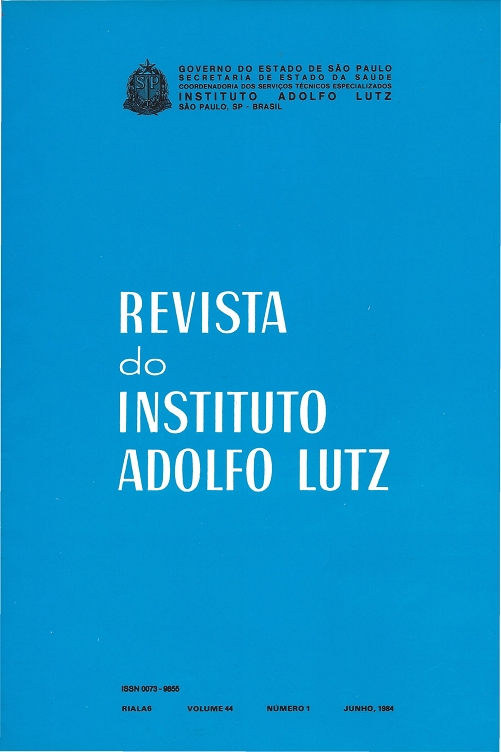Abstract
The relationship between the growth of Triatoma inf eetans nymphs
and the amount of blood fed were investigated in the laboratory. Two groups were ernployed, each composed of 180 nymphs in the first s tage, One of these groups was the sarnple tested by daily weighing while the other group was not weighed. 'I'he handling for weighing influenced the amount of blood sucked since the weighed group sucked 35% less blood compared with the unweighed group. The amount of blood sucked by the nymphs which died in the first stage was appreciably lower than that of the nyrnphs in the same stage but which survived to the next change. As the nymphs advanced in their evolutive stages, they needed more meal. For instance, in the first stage, 82.43% of nymphs required only one meal while in the fifth stage, 77.39% needed two or more meals. In the ear lier stages, when more than one me aI was needed, it was noted that those nymphs sucked more blood in the second meal compared with nyrnphs from the same stage that sucked only once,
Considerations on the laboratory rearing of T. infeetans are ma de on t~e basis of the results obtained.
References
2 ALMEIDA, S. P.; SHERLOCK, L A. & FAHEL, F. - Novo procedimento de xenodiagnóstico na forma crônica da doença de Chagas. Mem. Inst. Oswaldo Cruz, 74: 285-288, 1976.
3. BARRETTO, M. P. - Transmissores do TrypCLnosoma c1'uzi: os triatomíneos. In:
CANÇADO, J. R., ed. -' Doença de Chagas. Belo Horizonte, Fac. Med, Univ. Minas Gerais, 1968. p. 189-224.
4, CORRÊA, F. M. A. - Estudo comparativo do ciclo evolutivo do Triatoma infestans alimentado em diferentes animais (Hemiptera, Reduviidae). PCLp. Avulsos Dep. Zool., São Paulo, 15: 177-200, 1962.
5. DIAS, E. - Criação de triatomídeos em laboratório. Mem. Inst. Oswaldo Cruz, 33 :407-412, 1938.
6, DIAS, E. _ Notas sobre o tempo de evolução de algumas espécies de triatomíneos em laboratório. Rev. bras. Biol., 15:157-158, 1955.
7. DIAS, J. C. P. -Observações sobre o comportamento de triatomíneos brasileiros
frente ao jejum, em laboratório. Rev. bras. Malariol. Doenças trop., 17: -5563, 1965.
8. FREITAS, J. L. P. - Contribuição para o estudo da moléstia de Chagas por proces-
sos de laboratório. São Paulo, FMUSP, 1947. 160p.
9. FREITAS, J. L. P. - Observações sobre o tempo ótimo para o exame de triatomídeos empregados em xenodiagnóstico. Folia din. biol., 16: 180-185, 1950.
10. GOODCHILD, A. J. P. - Some observations on growth and egg production of blood-suckíng reduviids Rhodnius prolixus and Triatoma inf estane. Proc. R. entomol, Soc. Lond. (Ser. A Entomo!.), 30:127-36, 1955.
11. HACK, W. H. - Estudios sobre biologia del T'riatomainfestans (Klug, 1834) (Hem. Reduviidae ) . Ann. Lnsi: Med. Region., Corrientes, 4:125-147, 1955.
12. JUAREZ, E. - Observações sobre o ciclo evolutivo do T'riaioma arthurneivae, em condições de laboratório (Hemiptera, Reduviidae). Rev. Saúde públ., São Paulo, 4: 13-18, 1970.
13. JUAREZ, E .. - Comportamento do Triatoma infestans sob várias condições de laboratório. Rev. Saúde públ., São Paulo. 4:147166, 1970.
14. JURBERG, J. & RANGE L, E. F. - Observações sobre Rhodnius robustu8 Larrousse, 1927 e Rhodnius pallescens Barber, 1932 (Hemiptera, Reduviidae, Triatominae). Rev. bras. Biol., 40:569-577, 1980.
15. NEIV A, A. - Informações sobre a biologia do Conorhinus megistus Burmeister. Mem. Inst. Oswaldo Cruz, 2 :206-212, 1910.
16. NUSSENZWEIG, V. & SONNTAG, R.Xenodiagnóstico artificial. Novo processo.
Primeiros resultados positivos. Re». paul. Med., 40:41-43, 1952.
17. PERLOWAGORA-SZUMLEWICZ, A. - Ciclo evolu tivo do Triatoma infestans em condições de laboratório. Rev. bras. Malariol. Doenças trop., 5 :35-47, 1953.
18. PERLOW AGORA-SZUMLEWICZ, A. - Estudo sobre a biologia do T. infestans o principal vetor da doença de Chagas no Brasil (importância de algumas de suas características biológicas no planejamento de esquemas de combate a esse veto r) . Rev. bras. Malarial. Doenças trop., 21:11759, 1969.
19. SIQUEIRA, A. F. - Diagnóstico Parasítológico da moléstia de Chagas. In: CANÇADO, J. R., ed. - Doença de Chagas. Belo Horizonte, Fac. Med. Univ, Minas Gerais, 1968. p. 261-78.
20. TOLEZANO, J. E.; ARAÚJO, M. F. L.; RIBEIRO, S. S. & ISHIDA, M. M. r. - Efeitos do jejum e da temperatura na infectividade de triatomíneos por Trypanosoma, cruzi. Rev. Inst. Adolfo Lutz, 43 (1/2) :25-32, 1983.

This work is licensed under a Creative Commons Attribution 4.0 International License.
Copyright (c) 1984 Instituto Adolfo Lutz Journal
